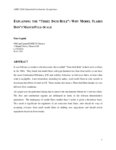TO
| Title | Date | Subject | Description | ||
|---|---|---|---|---|---|
| 226 |
 |
Evaluation of an eastern shale oil residue as an asphalt additive | 1995-09 | eastern shale oil; shale oil residue; asphalt additives | An evaluation of eastern shale oil (ESO) residue as an asphalt additive to reduce oxidative age hardening and moisture susceptibility was conducted by Western Research Institute (WRI). The ESO residue, having a viscosity of 23.9 Pa-s at 60°C (140°F), was blended with three different petroleum-deri... |
| 227 |
 |
Evaluation of oil shale bitumen as a pavement asphalt additive to reduce moisture damage susceptibility | 1991-01 | oil shale bitumen; pavement asphalt additive; moisture damage susceptibility; bitumen | An unrefined shale bitumen was evaluated as an agent to reduce moisture damage susceptibility of asphalt aggregate mixtures. Some activity was observed but less than might have been expected based on the molecular weight and nitrogen content of the bitumen. The countereffects of free carboxylic acid... |
| 228 |
 |
Evaluation of the potential end use of oils produced by the ROPE® process from California tar sand | 1989-12 | ROPE process oils; California tar sand; tar sand; oil products | The oil products from Process Development Unit (PDU) run SPR--111 were evaluated for potential end use. This particular run was a fiveday test using Arroyo Grande tar sand from California as the feed to the PDU. The distillate from knockout #2 was hydrotreated to produce a series of process intermed... |
| 229 |
 |
Evaluation of the Utah oil sand resource | 1976-08 | oil sand deposits; Utah oil sand; oil sand resource; Tar Sand Triangle; P. R. Spring; Sunnyside deposits; hydrocarbons; surface mining of oil sands | The three largest oil sand deposits in Utah, namely, the Tar Sand Triangle, the P.R. Spring, and the Sunnyside deposits, have been studied to contribute data relative to the surface and insitu mining of these deposits and to recommend research that should be conducted to develop the Utah oil sand re... |
| 230 |
 |
Experimental investigation for the development of burners for low scale reheating of semi-finished metal products | 2019 | recuperative burner; fuel rich combustion; direct fired furnace; scale reduction; radiant tube | Industrial furnaces for the reheating of semi-finished metal products are often direct fired with natural gas and air. Oxidation of the metals exposed to the furnace atmosphere causes significant material losses and additional work during furnace operation and in further processing. A reheating conc... |
| 231 |
 |
Explaining the "three inch rule": why model flares don't match full-scale | 2022 | It was Pohl and co-workers who discovered the so-called "Three Inch Rule" in their work on flares in the 1980s. They found that model flares with pipe diameter less than three inches do not have the same Combustion Efficiency (CE) and stability behaviour as full-scale flares, at least when wind is n... | |
| 232 |
 |
Feasibility of heavy-oil recovery | 1987-11-02 | heavy oil recovery; domestic liquid fuel; heavy oil reservoirs | This paper presents the results of a study completed in June 1984 that assessed the size, technical categorization, and potential of the U.S. heavy-oil resource base. Based on a proprietary data base containing nearly 1100 heavy oil reservoirs, the study concluded that heavy-oil resources in place i... |
| 233 |
 |
Feasibility study on a two stage benefits CO2 sequestration technology for fossil fuel power generation | 2009 | CO2 sequestration technology; fossil fuel power generation; emission and sequestration of green house gas; reducing pollution production | The issue of emission and sequestration of green house gas, especially CO2, becomes very hot and attracts international society to pay attention. The power generation plants firing fossil fuels, which is the biggest polluter in the world, emit huge amount CO2 into atmosphere every day and causes a s... |
| 234 |
 |
Field experiment of reverse combustion oil recovery from a Utah tar sand | 1980 | field experiment; reverse combustion; oil recovery; Utah tar sand; hydrocarbon reserves | A field experiment to recover oil from tar sand by reverse combustion was conducted at Northwest Asphalt Ridge, near Vernal, Utah. This test was in a 10-foot interval of the Rim Rock sandstone member of the Mesa Verde Formation at a depth of approximately 300 feet. Ignition was accomplished November... |
| 235 |
 |
Field testing of staged combustion on a petroleum process heater | 1980 | ||
| 236 |
 |
Final report on 1989 update of the computerized geologic model to include the 1988 drill hole data Sunnyside Tar Sands project Sunnyside, Utah | 1989-07 | computerized geologic model; 1988 drill hole data; Sunnyside Tar Sands project; geologic resources | In May 1989, Rozelle Consulting Services (RCS) was requested by Amoco Corporation (Amoco) to submit a proposed scope of work for updating the 1987 computerized geologic model of the Sunnyside Tar Sands deposit (Figure 1-1 and 1-2) to include the drill hole data that was completed in 1988 by Amoco. T... |
| 237 |
 |
Final report--volume 2: Publications and presentations | 1986-12 | Cooperative Agreement DE-FC21-83FE60177; Western Research Institute (WRI); DOE programs; oil shale; tar sand; underground coal gasification; advance process technology (APT); asphalt; annual and quarterly reports | Volume 2 of the final report for Cooperative Agreement DE-FC21-83FE60177 lists the publications and presentations by Western Research Institute (WRI) researchers under that agreement. Entries in this list represent the four major U.S. Department of Energy (DOE) programs included in that agreement ... |
| 238 |
 |
Fire and explosion hazards of oil shale | 1989 | fire and explosion hazards; oil shale; oil shale dust clouds; oil shale dust layers; oil shale rubble piles. | This U.S. Bureau of Mines publication presents the results of investigations into the fire and explosion hazards of oil shale rocks and dust. Three areas have been examined: the explosibility and ignitability of oil shale dust clouds, the fire hazards of oil shale dust layers on hot surfaces, and th... |
| 239 |
 |
Firing of liquid bio-derived fuels for decarbonization of high temperature industrial heating processes | Recent commitments to CO2/Green-House Gas emissions reductions by governmental, NGO and industrial corporations require that new energy sources be found to replace fossil fuels. While some are envisioning ‘The Electrification of Everything,' High temperature industrial heating processes have been ... | ||
| 240 |
 |
Flare combustion index in lieu of combustion zone net heating value | 2020 | Flares are commonly used at industrial facilities (e.g., oil and gas extraction and production sites, gas processing plants, oil refineries, and petrochemical manufacturing plants) to safely dispose of process waste gases. Waste gases may be produced due to process upset or because they are unrecove... | |
| 241 |
 |
Flare regulatory update | 2019 | The United States Environmental Protection Agency (USEPA) revised the regulations for the refinery through the Refinery Sector Rule (RSR) revisions to NESHAP CC and UUU (aka MACT CC and MACT UUU). The USEPA is expected to propose revisions to the Ethylene MACT and the Hazardous Organic NESHAP (HON) ... | |
| 242 |
 |
Flow of crushed oil shale through circular orifices | 1983-07-18 | crushed oil shale; oil shale; flow of oil shale; shale-oil recovery. | The gravity flow of crushed Colorado oil shale from a 7-in-diameter glass column through flat circular and converging conical orifices was studied using hign-speed cinematography. Factors tested were: (1) diameter of flat-entry and conical orifices, (2) three sizes of shale in one broad and two narr... |
| 243 |
 |
Fluidized-bed pyrolysis of oil shale | 1981-10 | Fluidized-bed pyrolysis; oil shale; isothermal fluidized-bed reactors; hydrocarbon evolution | Several quartz isothermal fluidized-bed reactors have been constructed in order to measure kinetics and oil properties relevant to surface retorting by fluidized-bed processes. The rate of volatile total hydrocarbon evolution is measured with a flame ionization detector, although various techniques ... |
| 244 |
 |
Fluidized-bed pyrolysis of oil shale: Oil yield, composition and kinetics | 1982-09 | fluidized-bed pyrolysis of oil shale; oil shale; oil yeild; oil composition; oil kinetics | A quartz isothermal fluidized-bed reactor has been used to measure kinetics and oil properties relevant to surface processing of oil shale. The rate of oil formation has been described with two sequential firstorder rate equations characterized by two rate constants. These rate constants together wi... |
| 245 |
 |
Further comparison of methods for measuring kerogen pyrolysis rates and fitting kinetic parameters | 1988-01-20 | measuring methods; kerogen pyrolysis rates; fitting kinetic parameters; kerogen pyrolysis; pyrolysis kinetics; Rock-Eval; pyrolysisMS/MS; hydrous pyrolysis; petroleum generation | We compare rates of product generation during pyrolysis of several petroleum source rocks and isolated kerogens by nonisothermal techniques, including Rock-Eval pyrolysis, condensed oil evolution, and pyrolysis MS/MS. We discuss problems related to temperature calibration in the Rock-Eval instrument... |
| 246 |
 |
Gasification studies - Task 4 topical report, Utah Clean Coal Program, Reporting period October 2009 - July 2011 | 2011-10 | Gasification; pressurized entrained-flow coal gasifiers; coal | A key objective of the Task 4 activities has been to develop simulation tools to support development, troubleshooting and optimization of pressurized entrained-flow coal gasifiers. The overall gasifier models (Subtask 4.1) combine submodels for fluid flow (Subtask 4.2) and heat transfer (Subtask 4.3... |
| 247 |
 |
Gasification studies: Task 4 topical report, Utah Clean Coal Program | 2014-02-06 | ICSE; Gasification; Large-eddy simulation; One-dimensional turbulence: Radiation; Soot formation; Entrained-flow coal gasification; Gasification kinetics; Slag formation | A key objective of the Task 4 activities has been to develop simulation tools to support development, troubleshooting and optimization of pressurized entrained-flow coal gasifiers. The overall gasifier models (Subtask 4.1) combine submodels for fluid flow (Subtask 4.2) and heat transfer (Subtask 4.3... |
| 248 |
 |
General kinetic model of oil shale pyrolysis | 1984-12 | oil shale; oil shale pyrolysis; pyrolysis | A mathematical model for pyrolysis of Green River oil shale is developed from previous experiments on oil, water, and gas evolution and oil cracking over a wide range of pyrolysis conditions. Reactions included are evolution of 5 gas species, oil, and water from kerogen, clay dehydration, oil coking... |
| 249 |
 |
Geologic evaluation and reservoir properties of the PR Spring tar sand deposit, Uintah and Grand counties, Utah | 1985-01 | reservoir properties; PR Spring tar sand deposit; tar sand | In 1980, the Laramie Energy Technology Center completed a seven corehole drilling program at the PR Spring tar sand deposit, southeastern Uinta Basin, Utah. The data from this project were integrated with other resource information to complete lithologic correlations, to evaluate general reservoir p... |
| 250 |
 |
Geologic influences on the in situ processing of tar sand at the northwest Asphalt Ridge deposit, Utah | 1985-01 | in situ oil recovery field experiments; oil recovery; tar sand; in situ tar sand processing; Asphalt Ridge deposit | The Laramie Energy Technology Center, Department of Energy, completed three in situ oil recovery field experiments, two combustion and one steamflood, in tar sand at Northwest Asphalt Ridge, Utah. Inadequate resource and site characterization prior to the field experiments contributed to process des... |
